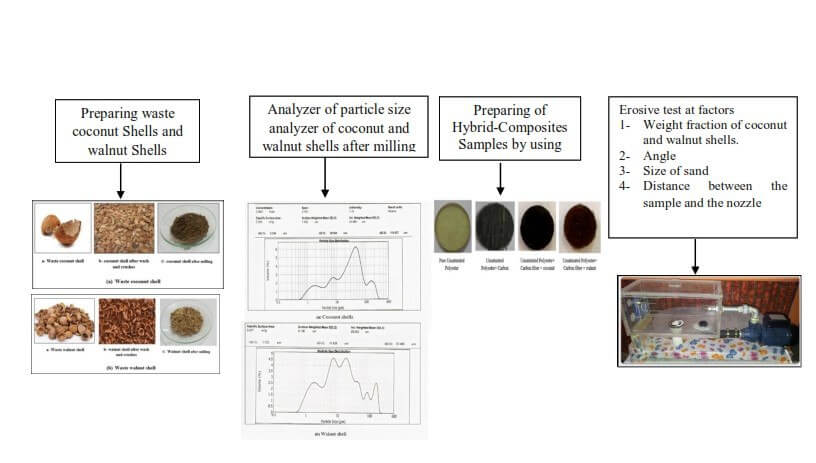 Open Access
Open Access
ARTICLE
Characterization of Unsaturated Polyester Filled with Waste Coconut Shells, Walnut Shells, and Carbon Fibers
Department of Materials Engineering, University of Technology-Iraq, Baghdad, Iraq
* Corresponding Author: Reem Alaa Mohammed. Email:
(This article belongs to the Special Issue: Recent advancements in thermal fluid flow applications)
Fluid Dynamics & Materials Processing 2023, 19(10), 2449-2469. https://doi.org/10.32604/fdmp.2023.027750
Received 13 November 2022; Accepted 18 January 2023; Issue published 25 June 2023
Abstract
This study aims to evaluate the erosion behavior and the hardness of hybrid composites made of varying amounts of coconut shells, walnut shells, and carbon fibers dispersed in a polyester matrix. MINITAB (L16) Taguchi experiments were used to determine the optimal combination of parameters. In particular, an erosion device consisting of a motor with a constant flow rate of 45 L/min, a pump with a diameter of 40 mm, a nozzle with a diameter of 5 mm, and a tank made of “perspex glass” 55 cm long, 30 cm tall, and 25 cm wide was used. The tests were conducted by varying the sample-to-nozzle distance, the pattern angle, and the sand particle size. The results have revealed that the presence of 7.5% by weight of waste coconut shell, for conditions corresponding to 90° angle, sand size 425 μm, stand distance 30 cm, gives the best wear resistance (3.04 × 10−5 g/g). The filler content and sand particle size affect the erosive rate, with the angle playing a secondary role. The distance between the sample and the nozzle has a weaker effect on erosive wear. The hardness results show that the models (UP-5% carbon fiber-2.5-3.5-4.5-5.5-6.5-7.5 wt.% waste coconut shell) give the best values for prayer compared to the samples (UP-5 wt.% carbon fiber-2.5-3.5-4.5-5.5-6.5-7.5 wt.% waste walnut shell).Graphic Abstract

Keywords
Cite This Article
 Copyright © 2023 The Author(s). Published by Tech Science Press.
Copyright © 2023 The Author(s). Published by Tech Science Press.This work is licensed under a Creative Commons Attribution 4.0 International License , which permits unrestricted use, distribution, and reproduction in any medium, provided the original work is properly cited.


 Submit a Paper
Submit a Paper Propose a Special lssue
Propose a Special lssue View Full Text
View Full Text Download PDF
Download PDF Downloads
Downloads
 Citation Tools
Citation Tools